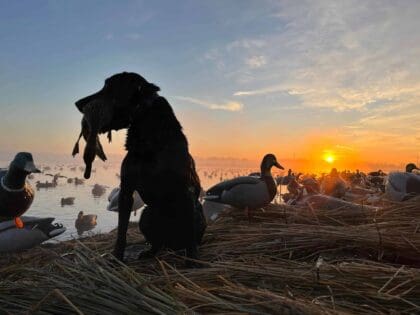Duck Hunting Tips
Waiting on legal shooting light under the cover of darkness with a hot thermos of coffee, busting chops with your buddies and watching those first few ducks tuck into your spread or fly dangerously close above your head. There is something about the wait which makes duck hunting special. Then, you watch the clock as five minutes turns to two which turns to one, and you stare at the clock until it turns to the legal shooting hour. Picking up your gun you head swivels in each direction until those birds finally close the distance, and the leader of hunt yells-take-em.
Duck hunting in my mind has gone from a gentleman’s leisure activity to a hard-core hunter’s pursuit. And how could it not? Having ducks’ decoy into your spread can be just as rewarding as a giant ten point passing within bow range. That being said, every duck hunter starts somewhere. If you are new to the sport, here are a few small details you might not read anywhere else.
Cover Your Back: You WILL read about staying covered. You WILL hear about blinds, camouflage and shadows. But if you are hunting in cattails or flooded timber, here is something easy to forget- covering your back. Building blinds is fun, but we become transfixed on the cover in front of us. Remember, birds are flying over you looking straight down on your position. Fooling their eyes as they circle is tough regardless of your camo pattern if you are exposed to the air. Think about their view from above. If you are a deer hunter like I am, this takes some getting used to since we are so concerned about what is below and in front of us.
Bends: Many of us cut our teeth on duck hunting creeks, channels or rivers. And while it may seem like a far cry from flooded timber, look for the bends and you will find a landing zone. Spend enough time on a river or a creek and you will realize a bend means slower water and larger surface area to land. From the air especially, the more surface area to land, the higher chance ducks will naturally gravitate to that spot. And if the point of landing is to rest, slower and still water on a moving body of water is a welcome relief. Bends in moving waters ways can be preliminarily scouted via the internet. My younger brother and I worked off of a screen shot of a piece of public land to find a few bends on a moving channel. The result was two limits of mallards in 40 minutes.
Keep Clean: “Dude, my gun is jammed.” Hearing or having to utter these words can be summed up in one word, frustration. Hunt ducks long enough and you will have this happen. The lessons I learned were to always keep my shells clean and dry as possible. Keep grit and mud off of them by storing shells in gallon freezer bags. The cardboard boxes shells come in are easily destroyed by moisture which exposes them to further dirt. And having gunk on the moving parts of a shot gun means you will be in for frustration.
Calling The Shot: Calling the shot is a job in which I believe the most experienced waterfowl in the group should handle. You work hard to fool birds into range, the last thing you want is miscommunication because there are too many chiefs in the kitchen so to speak. Pick one person and have them sit in the middle to have a clear and central view of the entire operation. In my world, the shot caller is my younger brother, a water fowling aficionado. By having one shot caller, the rest of us can keep our heads down and move less, staying hidden for that final approach and the words we crave to hear- Take-em!
Jason Reid
Last Updated: January 13th, 2015




